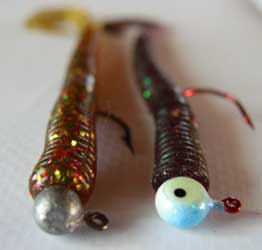Bass fishermen have known about the fish catching ability of a jigworm for decades. Yet the technique isn’t solely limited to targeting bass. Walleye anglers have discovered the productive nature of plastic for catching fish in specific situations.
 Most walleye anglers bet the farm on live bait, since leeches, crawlers and minnows have all proven to be top-notch producers in most conditions, so initiating a change in tactics can be difficult considering one’s success with the aforementioned presentations in the past.
Most walleye anglers bet the farm on live bait, since leeches, crawlers and minnows have all proven to be top-notch producers in most conditions, so initiating a change in tactics can be difficult considering one’s success with the aforementioned presentations in the past.
But the jigworm does have a place. When fishing areas where live bait is prohibited, go to a jigworm. When the panfish are particularly tenacious, go to a jigworm. When targeting specific isolated structural elements like timber and small weed clumps, and when fishing moving water in rivers and around dams, go to a jigworm because of its versatility, working on many bodies of water and in various situations.
Simply put, a jigworm is a jig-head, typically 1/16-1/2 ounce, with a four to six-inch worm threaded straight vertically onto the jig. If the worm isn’t straight, the worm will helicopter on the fall and rotate on the retrieve, which amounts to twisted line and less attention from the fish. Many companies manufacture plastic worms in various designs that function well for this application, but I prefer the Berkley Pulse Worm, and 4-inch Curltail. Bright colors work well in cloudy or muddy water, and more natural colors, brown, black or white, do best in clear water. However, fishing theory remains indefinite and there will be exceptions to the rule!
As the water temperature passes 70 degrees and the days become bright and hot, some walleye in natural lakes seek midday refuge in heavy weeds at medial depths. A jigworm is superb for those walleye that are positioning along coontail, cabbage, and milfoil edges. Locate these areas utilizing your electronics, focusing specifically on the area where the underwater vegetation transitions into smooth sand, rocks, rubble, or even silty grass.
A final technique that works well for covering water, as well as catching walleye, is to set the trolling motor at a moderate pace, letting the boat pull your bait, and twitching the jigworm by rapidly moving your rod tip 4-6 inches repeatedly until a fish slams your offering. A heavier ball or stand-up head functions best for this technique since the bait needs to return to the bottom each time you drop your rod tip back. The deeper the water, the heavier the jig. This works best on the outside edge of the weed to sand transitions.
My recommendation for those reluctant to temporarily give up their live bait confidence for a jigworm is to stick a pack of plastic worms in the tackle box and give them a chance the next time the crawlers don’t coerce, the shiners don’t shine, and the leeches, well, you get the picture.
Numerous retrieves in varying situations have proven fruitful, but experiment to find your niche. If your focus is indeed these weedline fish, cast into the weeds, slightly past the transition line, and allow the bait to hit bottom and sit for a few seconds before hopping it through the leafy jungle. If you hang up, rip the bait out and let it fall again. Often times that’s the cue that generates attention and the fish will take the bait as it falls.
Another retrieve that produces numbers of fish is to cast, patiently allowing the bait to arrive at the bottom, then reeling S-L-O-W-L-Y, keeping your rod tip at the ten o’clock position. This is exceptionally productive in rivers, since the fish need to instantaneously decide if they’ll eat a bait or let it pass in the current.










